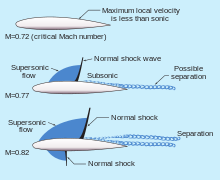Transonic flow
In the case of a transonic flow , areas with flow velocities in the subsonic and supersonic range occur simultaneously in the flow field of a compressible fluid .
In the case of an aircraft that is still flying at less than the speed of sound , the speed of sound can be exceeded locally in the flow around , that is to say locally. The transition from supersonic to subsonic flow in the air flow path is associated with a compression shock, which causes a high flow resistance and influences the pressure distribution on the aircraft. For a long time, therefore, exceeding the speed of sound with airplanes was an unsolved challenge, for which the term sound barrier was coined.
In the case of airplanes, the transonic range is for example flight mach numbers of Ma = 0.8 to 1.2. The airspeed from which a transonic flow condition occurs, that is, the lower limit of the transonic range, is denoted by the critical Mach number Ma crit .
